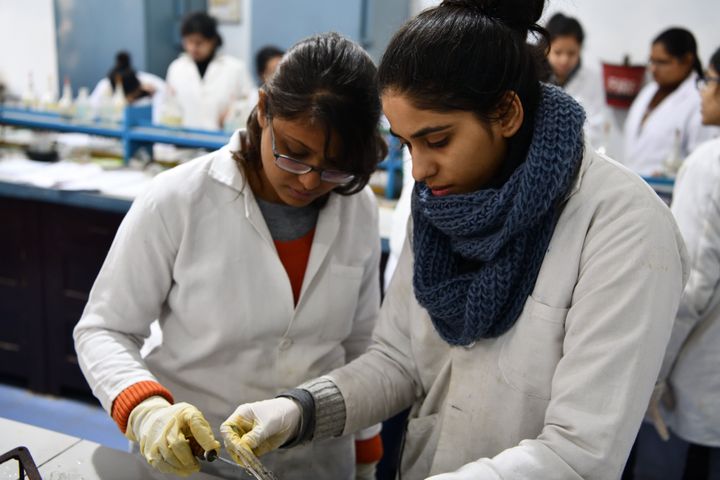
Rubina Mulchandani has been unable to do any field work for the past six months. A PhD scholar at the Indian Institute of Public Health in Gurugram, Mulchandani’s research involves travelling to tertiary hospitals in Delhi to collect data from cardiology OPDs. The first major hurdle was the Delhi metro grinding to a halt on 22 March, two days before the national lockdown began. Then came the other restrictions and health risks of the pandemic. While metro services restarted in September, Mulchandani, who has already lost precious time, says she’s unlikely to get on a train anytime soon because of the health and safety risks involved.
“Early research career fellows like me often do a lot of field work. There is only so much work you can do sitting at home. We are all facing that problem, but for women, due to the fact that we face additional constraints with travel and (our role as) primary caregivers, the impact of Covid is compounded,” said Mulchandani.
As the global scientific community focuses on Covid-19 research at the cost of other ongoing projects, women in science around the world, including in India, say the pandemic is widening the gender gap that already existed. Only about 14% of Indian scientists are women, the UN found in 2018, and attrition rates of women researchers at early career levels were high even before the pandemic. A new study by data scientists at research institute Monk Prayogshala shows that the number of Indian women publishing papers on Covid-19 is much lower than men.
“When I look around for other women in my position, I can’t really see them,” said Gagandeep Kang, a senior medical scientist in India who was, until recently, chair of an Indian Council of Medical Research (ICMR) task force on Covid-19 drugs and vaccines.
“This isn’t exclusive to Covid. Women are going to be sidelined in decision-making. That’s what we have gotten used to, and it is only likely to amplify,” added Kang, who acknowledged that the bulk of the strain is falling on early career researchers such as Mulchandani.
Many young researchers are also struggling to find funding for their work. For some months now, Mulchandani has been awaiting the results of the applications she sent to two prominent research funding bodies. But all she has been coming across are notices of further delay on their websites. “Even if the results do finally come out in two months, as the latest notice says, it would be a delay of one year,” she said.
“Out of 1,006 publications related to COVID uploaded on preprint servers between 1 December 2019 and 13 August 2020, the study identified only 1,724 women authors, compared with 4240 men.”
Mulchandani’s emails to the funding bodies have remained unanswered, leading her to suspect that “research funds may have been directed towards Covid-19 work”. This phenomenon, which has been dubbed ‘Covidisation’ of research, is being flagged as a grave concern by researchers as it not only takes away funding from those not doing Covid-19 work, it also invites non-experts into Covid-19 decision making. An open letter from May, signed by 35 women scientists researching on Covid-19 in North America and Europe, says: “Management consultants – largely male – with negligible relevant experience are making key decisions about the health of millions. Tech sector data scientists with no prior experience in any aspect of public health, biology or disease control are being “pulled-in” to task forces to discuss the finer points of contact tracing with policymakers. Senior male academics, famous for their innovations in other spheres, are giving public commentary with ill-informed modelling exercises, conjectures, or policy prescriptions with no basis in rigorous science.”
Moreover, while many senior scientists may have the freedom to ‘Covidise’ their research areas, such shifts are not an option for most early career researchers.
“If you are not working in Covid disease, drugs, diagnostics or vaccines—because that is where the funding is at, this is where prominence is being given—you may be under threat. Many people are forced to wonder if they should be thinking of shifting to some aspect of Covid because that is going to give you continued prominence. Because if you don’t, you might wind up in a situation where the work that you’re doing is discounted, at least for the moment,” said Kang, pointing out the conundrum her early career colleagues are facing due to Covidisation.
She put this in context of an already “scary” scenario in India.
“In our country, research funding is already being cut. So if you are a scientist and a researcher and you know that there is going to be a 30% cut in what has already been approved, how do you manage? What you are dealing with is a new situation, where you have more questions, not less, and yet resources are being cut. So how do you decide what to prioritise?” she asked.
Study shows gender gap in Covid-19 research
Hansika Kapoor, one of the authors of the Monk Prayogshala study mentioned above, explained the question they were trying to answer through the quick study: “How can we support or refute the finding that Indian women scientists working on Covid are being underrepresented, or what is the proportion between men and women in Covid-related output?”
Kapoor and her colleague Arathy Puthillam scraped data from three preprint repositories: PsyArXiv, arXiv and Bio/MedRxiv. The data was then coded by their colleagues to various variables, gender being one of them. A Google search of the authors was used to create secondary data on apparent gender presentation.
Out of 1,006 publications related to COVID uploaded on preprint servers between 1 December 2019 and 13 August 2020, the study identified only 1,724 women authors, compared with 4240 men.
“The gender gap base rate was calculated as the total number of women authors/total number of men authors, per archive. You can see that psychology has the greatest number of women, but you can also see how badly women are represented in biology/medicine and the ‘hard’ sciences—physics, mathematics, computer science, quantitative biology, quantitative finance, statistics, electrical engineering and systems science, and economics,” said Puthillam.
The authors conclude: “Overall, based on both the proportion of women who hold faculty and other positions of power in STEM and based on publication rates during COVID, we can say that there is a significant gender gap in publication. This is especially so in some subjects (e.g., Physics, computer science etc.) than others (e.g., psychology).”
The choice of the three preprint archives presents a comparison between “hard and soft science”—arXiv publishes papers on the hard side of the spectrum while one is likely to find more women working in psychology.
“We need to ensure that the solution (to close the gender gap) is systemic, rather than just trying to include more women, because even in a field like psychology, where by numbers, the proportion is more or less equal, there is some imbalance when it comes to positions of power and influence,” cautioned Puthillam, the first author of the study.
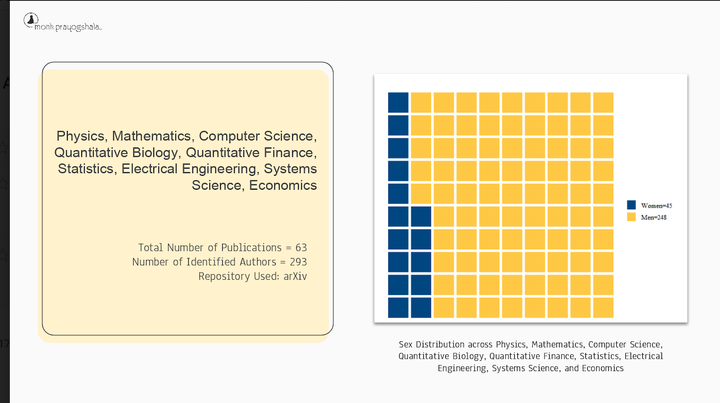
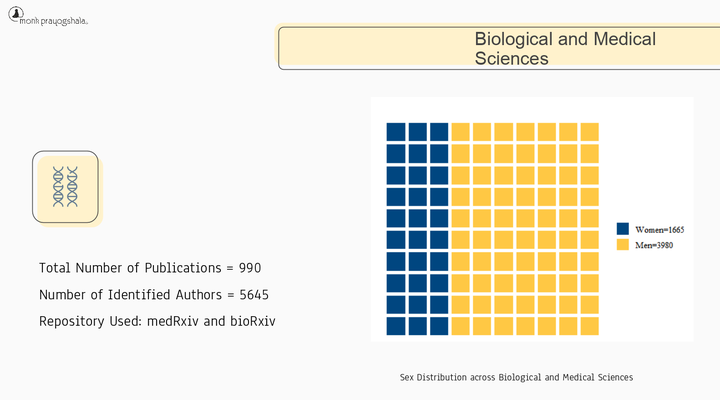
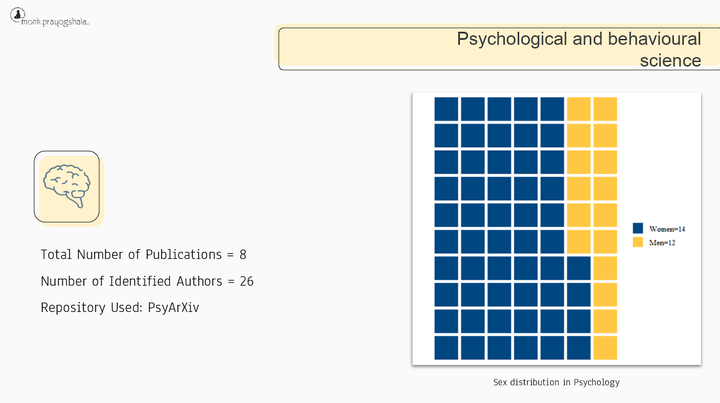
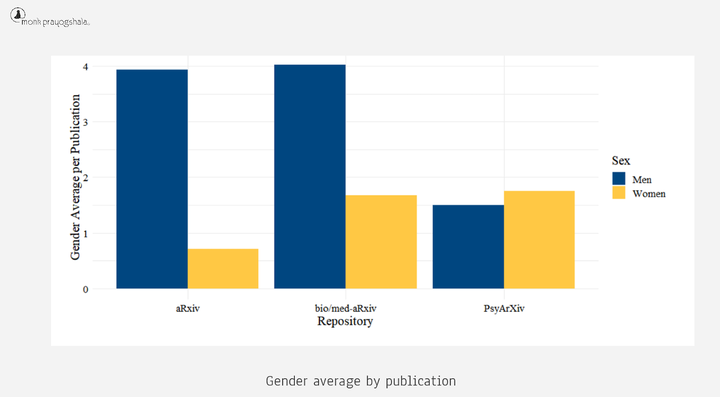
No help from universities, authorities
The challenges faced by early career researchers have been exacerbated by the lack of institutional support.
Deepika Choubey was employed as a Junior Research Fellow in a private university (which she does not want to name) until recently. Once the lockdown ended, she was requested to join the lab, which was many miles away from her home. When she was unable to turn up, she was de-registered from her JRF position, which she found out only when she tried unsuccessfully to log in to the lab’s website
“It is actually very discouraging for someone in my position. And this is not just me—a few months ago, another fellow, who also happens to be a woman, was asked to leave overnight.” Choubey urged institutions to start being “at least a little” responsible for their research students, citing the fact that many colleges and universities had asked hostels to be emptied, forcing students to leave campus when the crisis hit.
Some researchers trying to do field work during the lockdown also faced physical violence as well as penury.
“In our country, research funding is already being cut. So if you are a scientist and a researcher and you know that there is going to be a 30% cut in what has already been approved, how do you manage?”
- Gagandeep Kang
Kang, who leads several field teams, said that in May, she got a shocking phone call informing her of the police beating up field workers who were collecting samples for her group’s typhoid vaccine project. Besides police brutality, she said, “in my field teams, we have seen people having to deal with domestic violence, and the desperation of not being able to get out of containment zones to get their salaries. This includes people from various backgrounds and genders—from the ayahs managing the clinics to senior scientists.”
No government ministries or departments have announced any official studies to look into the pandemic’s impact on the gender gap. A press release from the Department of Science and Technology (DST) on 7 August announced an “interactive session” hosted by the KIRAN division of the DST for 70 Indian women in science. It is not clear what steps the department plans to take to mitigate the disproportionate impact of the pandemic on the work of Indian women in science. However, the release did say: “Women scientists working as Principal Investigators of projects found the session very useful and appreciated DST’s efforts to reach out to them and clear their doubts.” Queries emailed to the DST Media Cell remained unanswered. HuffPost India will update this story once they respond.
The open letter by women scientists cited earlier in this story says that even “the lifelong battles for a place in science” had left the researchers unprepared for the gendered and racial inequalities they were experiencing in response to the Covid-19 pandemic.
“The worst impacts of the coronavirus will undoubtedly be the loss of lives, the collapse of economies, the disruption of humanitarian aid and the decay of democracies. But we fear that the hard-won progress for women in science will be collateral damage of this crisis,” the letter reads.
One of the signatories of this letter was Krutika Kuppalli, a global health expert in infectious diseases; she has been the medical lead in setting up a Covid-19 field hospital in San Francisco and also served as expert witness in a hearing in the US House of Representatives to discuss how AI could help in the pandemic.
“In the lead-up to writing the letter, a number of us were professing the challenges women were facing during this pandemic and in particular how there are a lot of articles being written about how men were the ones leading the efforts against the pandemic (see here, here, here and here),” Kuppalli told HuffPost India, adding that she and her peers realised women’s efforts were going unrecognised.
“We thought that THAT was the story to tell. Because as we all know, women have not just been stepping up in leadership against this pandemic, but showing up in every shape and form. We wanted both the scientific and public community to know the role women have taken up,” she added.
A review of the Covid-19 response task forces of 24 countries found only 25% women in them and called “for more inclusive and transparent decision-making”. Another study where Kuppalli is one of the authors found that internationally, women make up only a third of clinical trial leadership.
“The science part of it is impacting everybody but there are social realities that get compounded to impact the women in science way more than it does the men. The problem is the hit that you take today is going to have consequences for a long time to come,” warned Gagandeep Kang.